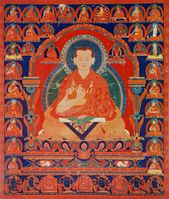Rong ston shes bya kun rig
Jump to navigation
Jump to search
The printable version is no longer supported and may have rendering errors. Please update your browser bookmarks and please use the default browser print function instead.
Rong ston shes bya kun rig on the DRL
རོང་སྟོན་ཤེས་བྱ་ཀུན་རིག་
| Wylie | rong ston shes bya kun rig |
|---|---|
| English Phonetics | Rongtön Sheja Kunrik |
Other names
- ཤཱཀྱ་རྒྱལ་མཚན་
- སྨྲ་བའི་སེངྒེ་
- ཤེས་བྱ་ཀུན་གཟིགས་
- རོང་ཊཱི་ཀ་པ་
- ཤེས་རབ་འོད་ཟེར་
- shAkya rgyal mtshan
- smra ba'i seng+ge
- shes bya kun gzigs
- rong TI ka pa
- shes rab 'od zer
Alternate names
- Rongtön Shéja Günsi
- Rongton Sheja Kunrig
Dates
| Birth: | 1367 |
|---|---|
| Death: | 1449 |
| Place of birth: | rgyal mo rong |
Tibetan calendar dates
| Day | |
|---|---|
| Month | |
| Gender | Female |
| Element | Fire |
| Animal | Sheep |
| Rab Jyung | 6 |
About
- Religious Affiliation
- Sakya
- Primary Professional Affiliation
- Nalendra Monastery
- Other Professional Affiliation
- Sangpu Neutok
- Teachers
- g.yag ston sangs rgyas dpal · gnyag phu ba bsod nams bzang po
- Students
- shAkya mchog ldan · 'gos lo tsA ba gzhon nu dpal · go rams pa bsod nams seng ge · Karmapa, 6th · dkon mchog rgyal mtshan
Other Biographical info:
Links
- BDRC Link (P431)
- https://www.tbrc.org/#!rid=P431
- Treasury of Lives Link
- https://treasuryoflives.org/biographies/view/Rongton-Sheja-Kunrig/6735
- Treasury of Lives Excerpt
- Rongton Sheja Kunrik is the second in the line of great Sakya masters known as the Six Ornaments of Tibet. Among these teachers he is particularly revered for his mastery of the Buddhist sutras. Rongton studied and taught at Sangpu Neutok Monastery. He founded Penpo Nalendra Monastery in 1436.
- Himalayan Art Resources Link or Other Art Resource
- https://www.himalayanart.org/items/89472
- Wiki Pages
- Rong ston shes bya kun rig on the DRL
- Rong ston shes bya kun rig on the LIB
- Rong ston shes bya kun rig on the BNW
Buddha Nature Project
- Person description or short bio
- Rongton Sheja Kunrik is the second in the line of great Sakya masters known as the Six Ornaments of Tibet. Among these teachers he is particularly revered for his mastery of the Buddhist sutras. Rongton studied and taught at Sangpu Neutok Monastery. He founded Penpo Nalendra Monastery in 1436.
Expand to see this person's philosophical positions on Buddha-nature.
| Is Buddha-nature considered definitive or provisional? | |
|---|---|
| Position: | Definitive |
| Notes: | Generally speaking, Rongton's commentary on the RGV, which he wrote at Sangphu, follows the rngog lugs. |
| All beings have Buddha-nature | |
| Position: | Qualified No |
| If "Qualified", explain: | Sentient beings are endowed with the naturally abiding gotra, but not the dharmakāya. |
| Notes: | |
| Which Wheel Turning | |
| Position: | |
| Notes: | |
| Yogācāra vs Madhyamaka | |
| Position: | Madhyamaka |
| Notes: | |
| Zhentong vs Rangtong | |
| Position: | Rangtong |
| Notes: | |
| Promotes how many vehicles? | |
| Position: | |
| Notes: | |
| Analytic vs Meditative Tradition | |
| Position: | Analytic Tradition |
| Notes: | |
| What is Buddha-nature? | |
| Position: | Tathāgatagarbha as the Latent State of Buddhahood that is Obscured in Sentient Beings |
| Notes: | "Rongtön explains that what is called “the tathāgata heart” is suchness with stains (the basic element not liberated from the cocoon of the afflictions), which is the emptiness of mind with stains. By contrast, the dharmakāya of a tathāgata is what is liberated from this cocoon. The term “tathāgata heart” is used in terms of what is primary because this heart (in the sense of emptiness) is explained to exist at the time of the fruition too. This also refutes the assertion that the fully qualified tathāgata heart is solely the buddhahood that is endowed with twofold purity (natural purity and purity of adventitious stains) because it is explained repeatedly that the primary tathāgata heart is suchness with stains. Rongtön’s commentary on the Abhisamayālaṃkāra says that the Mādhyamikas identify the disposition as the dharmadhātu specified by the six inner āyatanas." Brunnhölzl, K., When the Clouds Part, p. 76. |
| Svātantrika (རང་རྒྱུད་) vs Prāsaṅgika (ཐལ་འགྱུར་པ་) | |
| Position: | |
| Notes: | |
| Causal nature of the vajrapāda | |
| Position: | |
